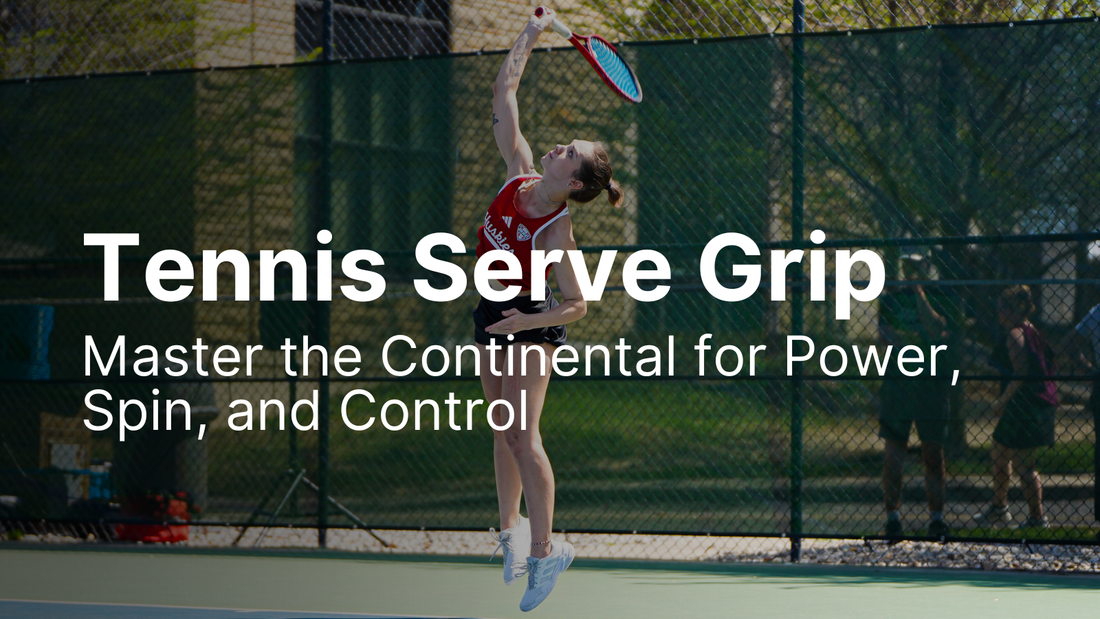Tennis Serve Grip: Master the Continental for Power, Spin, and Control
The serve sets the tone of every point. It can hand you free points, protect your second serve under pressure, and open the court for easy finishes. Yet for many players, the secret to a reliable, versatile serve begins with a deceptively simple foundation: your grip. In this deep guide, we’ll break down the best tennis serve grip for long-term growth, how to hold it, when to adjust it for different spins, and how to train the movement so your serve becomes a true weapon.
Why Your Grip Matters More Than You Think
If your serve feels inconsistent—or if your shoulder or elbow aches after a session—your grip may be the quiet culprit. The right grip does three crucial things:
- Aligns the wrist, forearm, and shoulder for safe, repeatable mechanics
- Unlocks pronation so you can generate effortless power and spin
- Expands your toolkit so flat, slice, and kick serves all feel natural off the same toss
That’s why most coaches recommend the Continental as the gold standard. It’s the most efficient tennis serve grip for players who want to grow beyond a beginner’s flat tap-in. With it, you can vary spin, disguise your intent, and scale your power without reinventing your motion.
The Continental Grip: The Swiss Army Knife of Serves
The Continental grip puts the base knuckle of your index finger on bevel 2 (imagine the racquet handle as an octagon). If you’re holding the racquet like a hammer—ready to tap a nail—you’re close. Signs you’ve got it right:
- Your strings naturally face the side fence at trophy position, not the court
- Your wrist feels neutral (not laid back like a forehand or cranked like a backhand)
- You can pronate—rotate the forearm so the strings square to the ball at contact—without forcing it
Benefits of the Continental:
- Seamless spin variety: Flat, slice, and kick all off nearly identical tosses
- Better biomechanics: Encourages healthy shoulder rotation and forearm pronation
- Disguise: Opponents can’t easily read your serve because your preparation looks the same
Want to go deeper on kick mechanics after you dial in the grip? Check out Kick Serve in Tennis: Technique, Toss, Drills, and Pro Tips.
How to Find the Continental in Seconds
- Hold the racquet frame in front of you with your non-dominant hand.
- Place your dominant hand on the handle as if shaking hands with it.
- Slide the base knuckle of your index finger to bevel 2 (just to the right of the top bevel for righties; left for lefties).
- Check that your thumb wraps comfortably around the handle—not pressed up the back like a two-handed backhand.
A quick test: Move to a trophy pose. If your strings face the side fence and your elbow can internally rotate naturally, you’ve likely nailed the tennis serve grip.
Common Alternatives—and When They Work
Some players start with an Eastern forehand grip because it feels natural to “push” the ball. While that can help you land more first serves early on, it limits spin, stresses the wrist on kick serves, and stalls long-term growth. An Eastern backhand grip, on the other hand, can help emphasize topspin and kick, but it can be extreme for flat and slice serves. If you’re serious about developing a full serve arsenal, think of the Continental as home base.
Grip Tweaks for Every Serve Type
Small, purposeful adjustments around the Continental can fine-tune spin and contact:
Flat Serve
- Grip: True Continental
- Toss: Slightly into the court, just right of your hitting shoulder (righties)
- Key: Drive up and out with a strong pronation; think “edge to ball, then square”
Slice Serve
- Grip: Continental, rotate a hair toward Eastern backhand if you crave more bite
- Toss: Slightly to the right (righties) and a touch forward
- Key: Swing from “3 o’clock to 9 o’clock” across the ball with full body turn and pronation
Working on sidespin? This pairs perfectly with our tutorial energy around spin. If you want a dedicated how-to, bookmark this topic alongside your tennis serve grip practice and dive into high-accuracy targets later.
Kick (Topspin) Serve
- Grip: Continental with a micro-rotation toward Eastern backhand for extra topspin
- Toss: Above or slightly left of your head (righties), keeping it close to your body
- Key: Brush “up the back” of the ball with a vertical swing path and aggressive upward acceleration
For a full breakdown on topspin mechanics, toss geometry, and drills, see Kick Serve in Tennis: Technique, Toss, Drills, and Pro Tips.
Your Toss: The Unsung Hero of a Great Serve
A perfect grip paired with a wild toss won’t win many points. Train a consistent toss that suits all spin types so you can disguise intent. Key notes:
- Release the ball from your fingertips, not your palm
- Keep your tossing arm long and slow; the slower the arm, the straighter the toss
- Set the apex slightly in front for flat/slice; above or slightly left for kick (righties)
Want to pressure-test your toss? Hit 10 serves without moving your feet. If you can land 8/10 in the same hitting window, you’re on track. Pair this with our guide on movement improvements: Tennis Footwork Drills: Proven Routines to Move Faster and Win.
Step-by-Step Progression: Build a Serve That Scales
Phase 1: Shadow and Trophy
- With your tennis serve grip set, rehearse 10–15 slow-motion serves
- Stop at trophy position; hold for two seconds and check: shoulders turned, elbow up, wrist neutral
- Finish with relaxed follow-through across your body
Phase 2: Contact Above the Head
- Serve from the service line to reduce effort
- Focus on meeting the ball high, with forearm pronation and a fully extended hitting arm
- Add targets: deuce wide, T, body; ad wide, T, body
Phase 3: Add Pace and Spin
- Move to the baseline
- Alternate sets: 6 flat to the T, 6 slice wide, 6 kick to the ad
- Track make percentage and average depth (second-hop near back fence is a good proxy for depth/pace)
Serve Drills You Can Do Today
- Basket 3-Spot: Hit 10 serves to each spot (deuce wide/T, ad wide/T). Track first-serve percentage.
- Spin Ladder: 5 flat, 5 slice, 5 kick. Repeat for 3 rounds. Note which spin you miss long vs. in the net.
- Hold-It Toss: Freeze at trophy for two seconds before swinging. This teaches balance and rhythm.
- Up the Ladder: Begin at service line and move back a step every 5 successful serves. Miss twice and step forward.
Fixing the Most Common Serve Problems
Problem: Serves sailing long
- Likely Cause: Forehand grip or early opening of the racquet face
- Fix: Refind the Continental; feel the “edge” of the racquet lead to the ball before pronating to square
Problem: Serves into the net
- Likely Cause: Contact too low or toss too far back
- Fix: Raise the toss apex; cue “reach up to scratch the sky” for higher contact
Problem: Wrist pain
- Likely Cause: Excessive wrist flick with non-neutral grip
- Fix: Neutral Continental, power from legs and trunk, and a relaxed wrist that pronates rather than snaps
For broader scoring know-how (and to relieve scoreboard anxiety when you finally hold more often), revisit Tennis Scoring: Sets, Games, Points, Match.
Equipment Tips That Support a Better Serve
- Racquet balance: Slightly head-light frames can help accelerate pronation and protect the arm
- String and tension: For control and arm-friendliness, many players prefer a hybrid at mid tension; see Best Tennis Racquets for Intermediate Players to match your style
- Grip size: Too large inhibits wrist mobility; too small may overwork the forearm
If your arm is sensitive, mix technique and fitness solutions. Building forearm and shoulder stability can help. For prevention strategies, consult medical sources and evidence-based tips from governing bodies.
Biomechanics and Best Practices from the Pros
Here is a great resource to deepen your serve knowledge:
- International Tennis Federation: The biomechanics of effective serve mechanics and pronation are outlined here: https://www.itftennis.com/en/news-and-media/articles/biomechanics-of-the-tennis-serve/
These fundamentals align with what top coaches teach: a solid tennis serve grip, a high contact point, a fluid kinetic chain, and reliable pronation form the backbone of a world-class serve.
Serve Strategy: Turn a Good Grip into Free Points
Once your grip and launch mechanics feel natural, layer in patterns to exploit returners:
- Deuce court: Slice wide to pull the returner off court, then attack the open space
- Ad court: Kick up and at the backhand shoulder; if they cheat, flatten the T
- Body serves: Jam first balls to steal time; mix pace and spin to draw mishits
If singles play is your focus, pairing serve patterns with smart rally plans compounds your edge. Explore concepts in Tennis Footwork Drills and keep your progress tied to real match goals with UTR.
Measuring Progress the Smart Way with UTR Sports
Improvement is addictive when you can see it. Track your match results, find level-based competition, and watch your progress translate into a more trustworthy rating inside the UTR Sports ecosystem.
- Understand how the rating reacts to quality of opponent and scorelines in Understanding the UTR: Frequently Asked Questions
- Learn the system’s principles in How UTR Works
- Use practical match and training tactics to raise your level in How to Move Up One UTR Level
Because UTR is dynamic, every verified match you play adds clarity. As your serve holds more often, tight sets flip your way, and your level climbs, your rating can reflect that growth. It’s the perfect feedback loop for anyone working on a stronger serve foundation—starting with the right tennis serve grip.

FAQ: Quick Answers to Keep You Serving with Confidence
Is the Continental the only correct grip for the serve?
It’s the most versatile and widely recommended tennis serve grip. Some pros make tiny adjustments for different spins, but the Continental is the best home base for power, spin, disguise, and arm health.
How do I know my grip is working?
Your serve should feel smoother at contact, with the racquet “carving” the ball rather than slapping it. You’ll also notice better spin potential on second serves and less strain on the wrist and elbow.
Can a good grip prevent tennis elbow?
A proper grip helps by aligning the arm and encouraging pronation, which can reduce stress. Combine that with progressive loading, smart string choices, and recovery. If you’re battling elbow sensitivity, consult a medical professional and consider evidence-based exercise protocols.
How long does it take to adjust?
Give yourself 2–4 weeks of consistent practice. Start close to the service line and prioritize clean contact over speed. Your feel and confidence will build quickly with focused reps.
Put It All Together: Your 2-Week Serve Plan
- Days 1–3: Shadow reps to trophy and freeze; 50 light service-line contacts per session
- Days 4–7: Baseline baskets with 3-spot targets; track make percentage
- Days 8–10: Add slice and kick ladders; refine toss consistency
- Days 11–14: Serve + 1 pattern practice (e.g., slice wide, attack open court); play two match tie-breaks and log results in UTR
Support your work with targeted reads: Tennis Scoring to compete confidently and Best Tennis Racquets for Intermediate Players to ensure your frame suits your serve goals.
Final Thoughts
Your serve becomes a genuine weapon when the fundamentals are dependable and repeatable. The Continental—a time-tested tennis serve grip—gives you the blueprint for safer mechanics, bigger power ceilings, and true spin variety. Pair it with a steady toss, upward acceleration, and clear practice plans, and you’ll unlock not just better holds, but more commanding points and freer swings under pressure.
About UTR Sports: Find Play, Track Progress, and Level Up
UTR Sports helps players of all ages and levels find competitive, level-based play and measure improvement over time. Join free to create your player profile, search for local matchplay, leagues, and tournaments, and see where your level stands—then watch it rise as your serve does. Sign up here: https://app.utrsports.net/join.
For more on ratings, events, and how to maximize your competitive journey, explore:
Ready to serve bigger, smarter, and with more confidence? Your next hold starts with your grip—and your next level starts with UTR Sports.













